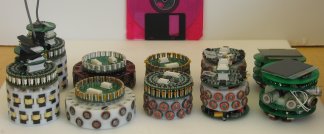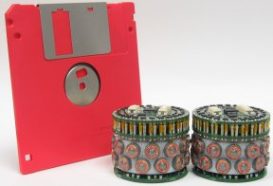Shape Shifting
A futuristic technology aims to have a pile of tiny, robotic beads arrange itself into different shapes.
Share this:
- Share via email (Opens in new window) Email
- Click to share on Facebook (Opens in new window) Facebook
- Click to share on X (Opens in new window) X
- Click to share on Pinterest (Opens in new window) Pinterest
- Click to share on Reddit (Opens in new window) Reddit
- Share to Google Classroom (Opens in new window) Google Classroom
- Click to print (Opens in new window) Print
By Emily Sohn
Using a cell phone, you can hear your friend when she calls. With a video camera or picture phone, you can also see her. But what if you could have a technology that made it seem as if your friend were sitting across from you, even if she’s actually at home in another state?
 |
|
A picture phone lets you see your friend. What if you had an imaging technology that created a three-dimensional look-alike of your friend? |
| iStockphoto.com |
That’s the crazy idea behind the claytronics project at Carnegie Mellon University and Intel Research in Pittsburgh. Claytronics is the term that project researchers use for a form of programmable matter.
The idea is to have a huge bunch of microscopic, robotic units that can arrange themselves into different three-dimensional objects.
Find that idea hard to grasp? If so, just picture a pile of minuscule beads that can arrange themselves to look like your faraway friend at one moment, a chair the next moment, and maybe a mechanical dog after that. That’s what claytronics might make it possible to do. If you’ve ever played with modeling clay, you know that this new concept is aptly named.
“It’s hard to wrap your head around the idea,” Seth Goldstein admits. A computer scientist at Carnegie Mellon, he and Todd Mowry of Intel came up with the idea for claytronics several years ago.
Claytronics is so far out that computer scientist Peter Lee, who’s also at Carnegie Mellon, was dumbfounded when Goldstein told him about it. “It’s a completely crazy idea, but it’s also a really great idea,” he says. “I think it’s bound to lead to a lot of new discoveries.”
If it works, claytronics could transform communication, entertainment, medicine, and more. The research may help scientists learn how to better manage networks that consist of millions of computers. It will also advance their understanding of nanotechnology—how to make tiny, tiny parts do useful things.
Programmable atoms
Signals from a video camera light up a screen in just the right way to create an image of whatever the camera captures. With claytronics, the imaging system would make a three-dimensional copy of whatever it detects.
So, when a friend called you, a moving, sensing copy of your friend would take shape in your room, assembled out of a pile of special beads, each one a microscopic robot. You could talk with and touch this look-alike friend, and she could do the same. It would almost be as if you and your friend were in the same room.
But getting from today’s technology to tomorrow’s 3-D images isn’t going to be easy. The robot beads needed for such a system not only have to be extremely small but also need to know what to do.
 |
|
At Carnegie Mellon, researchers are building little units, called catoms, that interact with each other and may eventually be able to assemble themselves into different shapes. |
| Courtesy of Seth Goldstein |
At Carnegie Mellon, researchers are working on the miniature robot beads that would rearrange themselves into an object. They call these units catoms. Right now, the units are pretty big—44 millimeters wide. Eventually, they’ll be less than a millimeter across.
Each catom will have a little computer, or processor, access to power, a communication system, sensors, and a way to stick to other catoms and even change color.
Goldstein and his coworkers are currently focusing on catoms that move about only on a flat surface. Each catom is a cylinder with electromagnets all along its rounded side. Magnetic attraction and repulsion allow the catoms to move about and respond to each other.
When a programmer sends a command, catoms are supposed to work together to create a particular shape. “When in contact with other catoms,” Lee says, “they share [electrical] power and become a computer network.”
 |
|
Getting catoms to do what they’re supposed to do is a tricky problem. |
| Courtesy of Seth Goldstein |
But figuring out how to make the catoms arrange themselves into the right shapes is a tough problem, even when they’re allowed to move only on a flat surface instead of in three dimensions. And the more units there are, the tougher it gets. For claytronics to work, millions of these microrobots will have to work together.
Endless possibilities
If and when scientists figure it all out, the possibilities are pretty amazing.
Your toys could change shape day by day. You could play video games with people whose claytronics look-alikes interact with you, even though the players themselves live elsewhere.
 |
|
To receive various radio and TV signals, antennas sometimes have complicated shapes. An antenna made from programmable matter could change its shape to suit the signal being received. |
| iStockphoto.com |
If you had a medical emergency, a claytronics version of you could form in your doctor’s office, and a version of your doctor could appear in your home. Using a phone or an Internet link, the doctor could examine you.
Even if these virtual doctors never make it from the drawing board, developments in claytronics could lead to improvements in communication systems. For example, a claytronics antenna could change its shape to improve its ability to receive different radio frequencies.
The ability to get claytronics units to work together could also lead to improved communication among large numbers of computers in huge networks.
Within the next 20 years, Goldstein predicts, claytronics could enable biologists to make large, 3-D models of complex molecules called proteins. Using these models, researchers could see how the proteins fold and interact with one another. Architects could use catoms to make miniature models of bridges and buildings.
Some of the more fantastic applications may never happen, Lee says. Then again, a claytronics world may arrive in your lifetime.
Crazy ideas have a way of becoming reality. A generation or two ago, few people could imagine singing greeting cards, DVD players, iPods, and PlayStation systems. Now, they’re everywhere.
Going Deeper:






